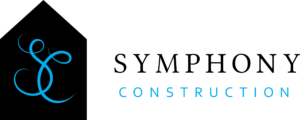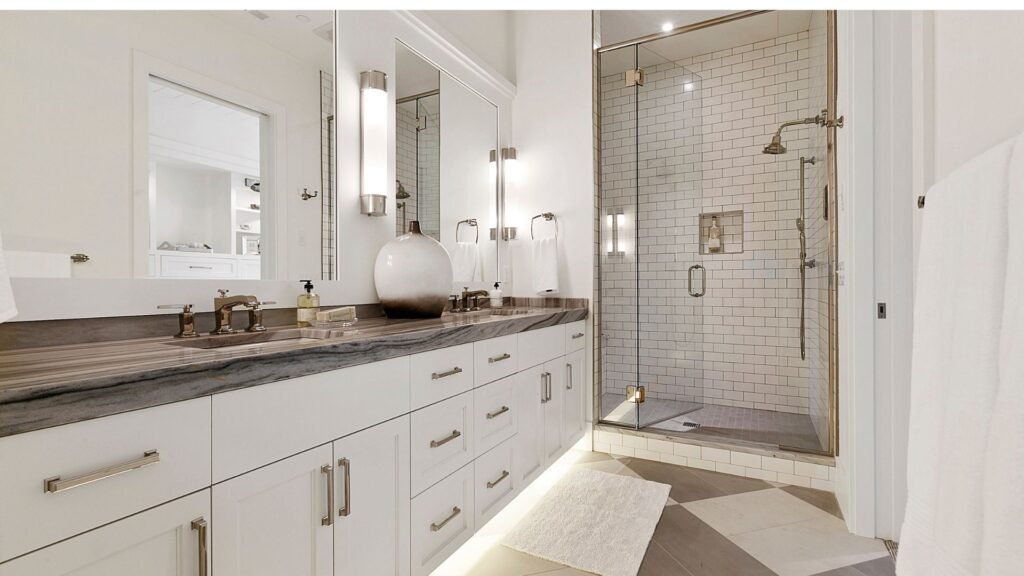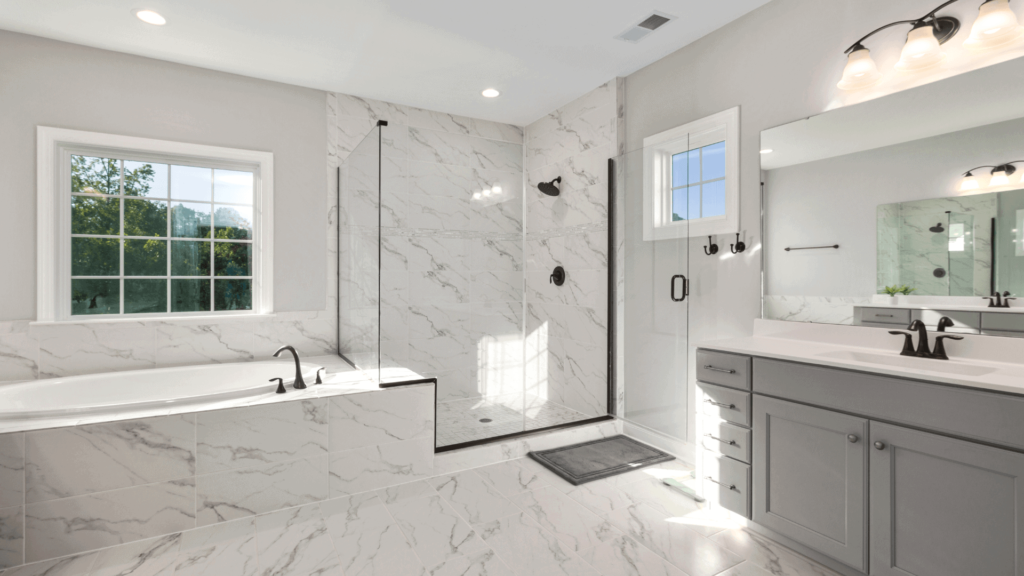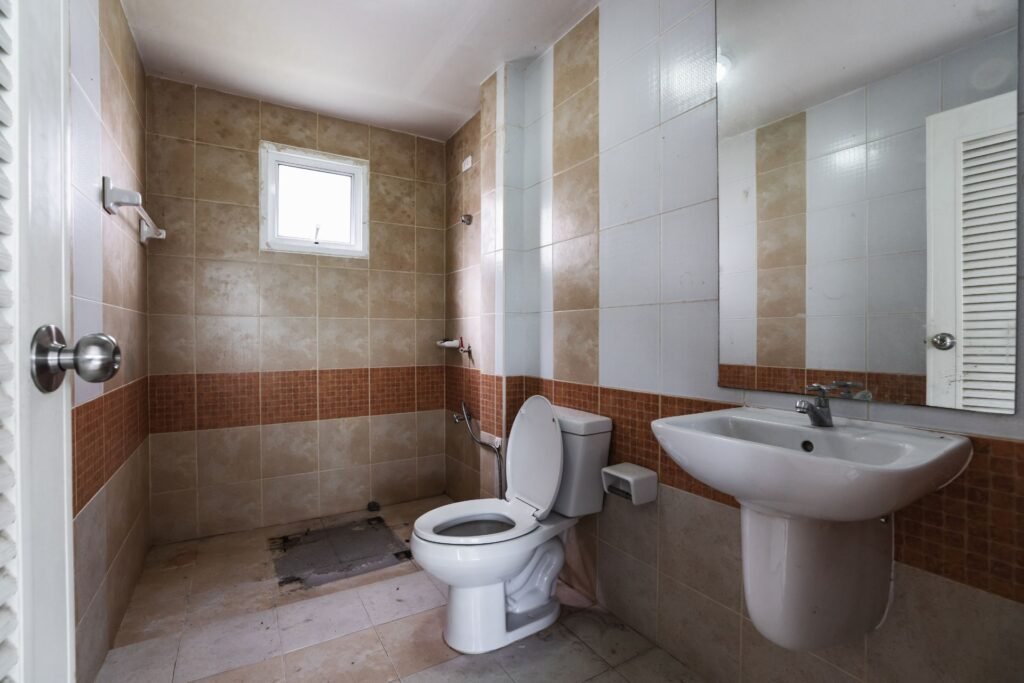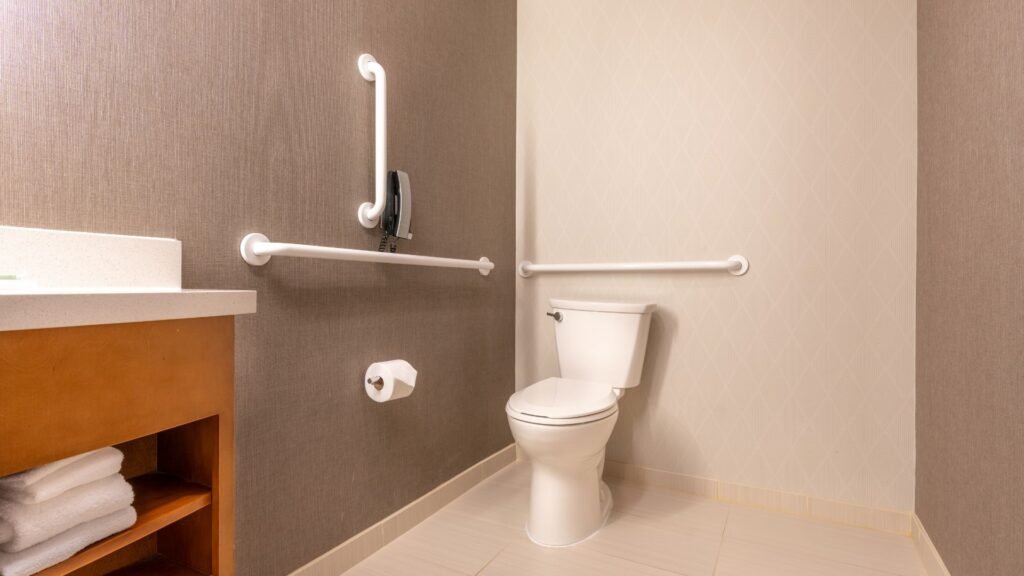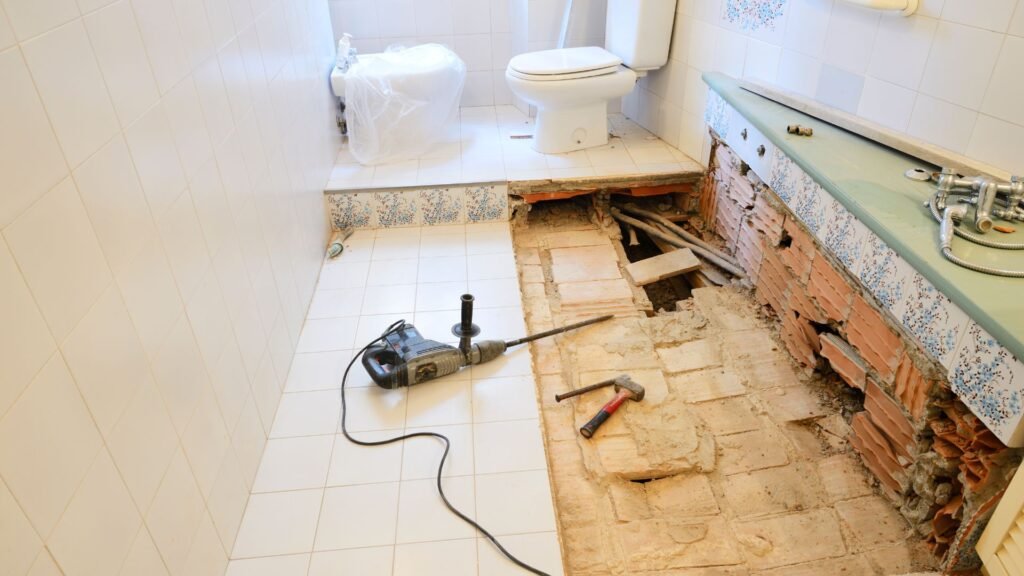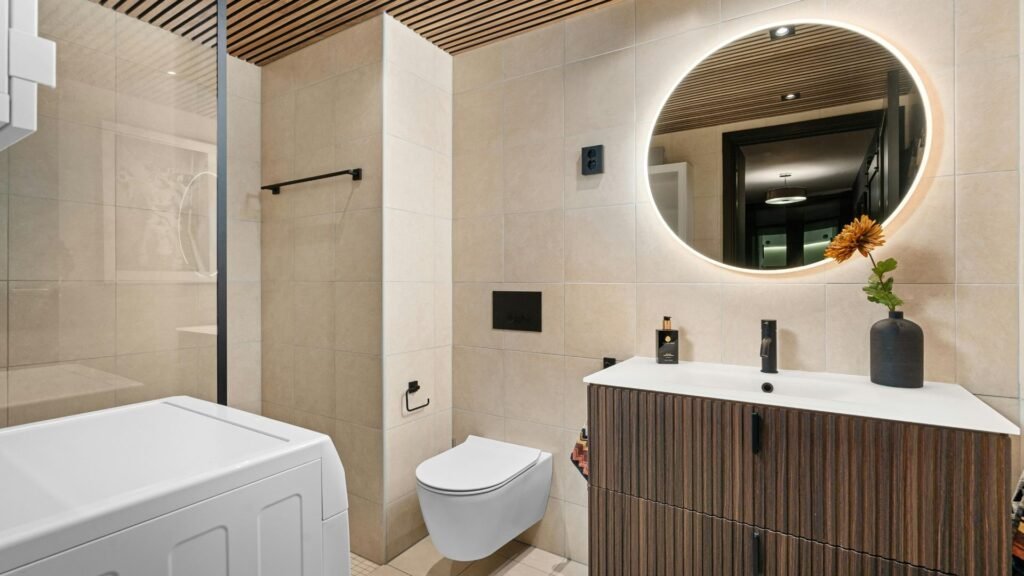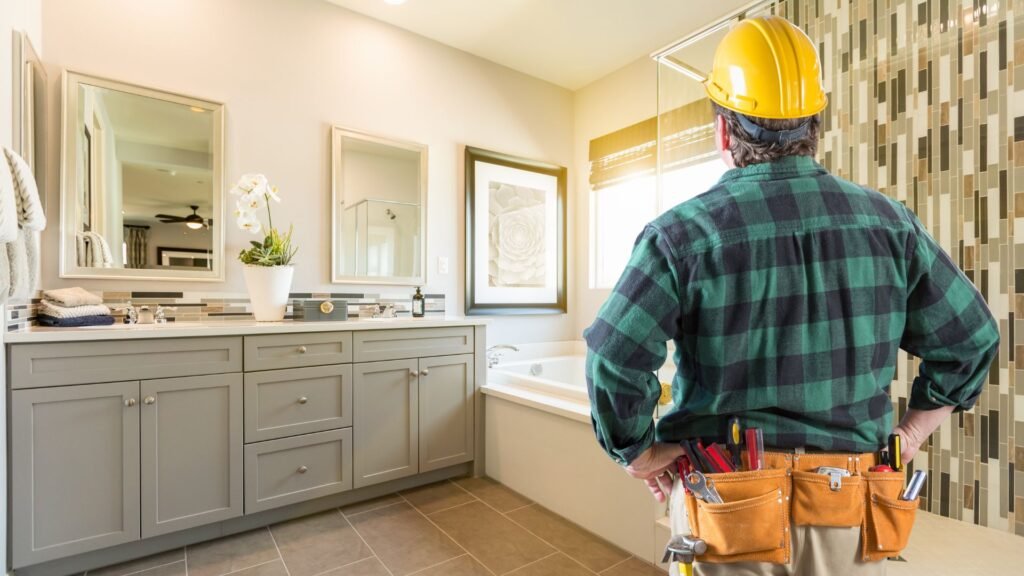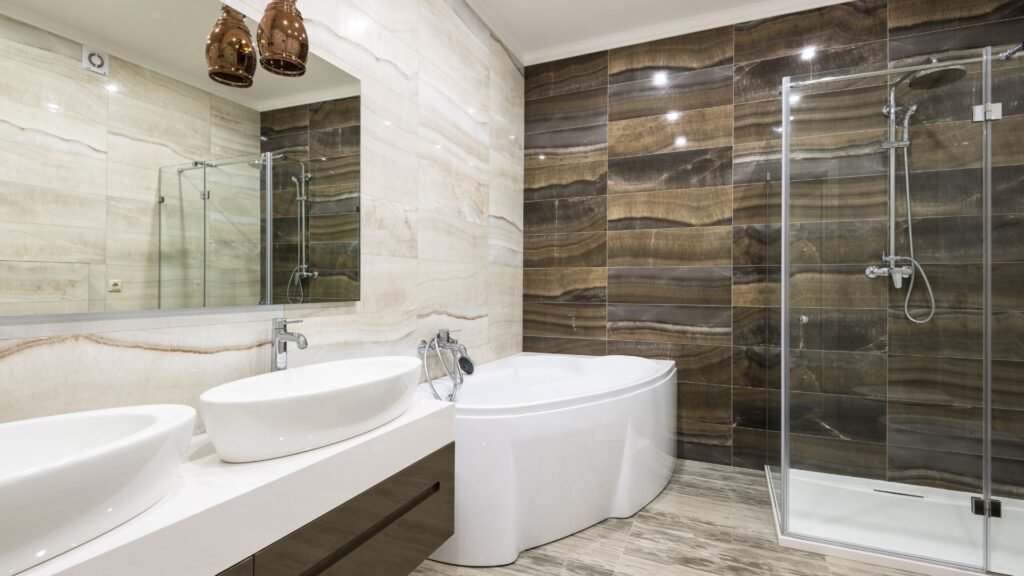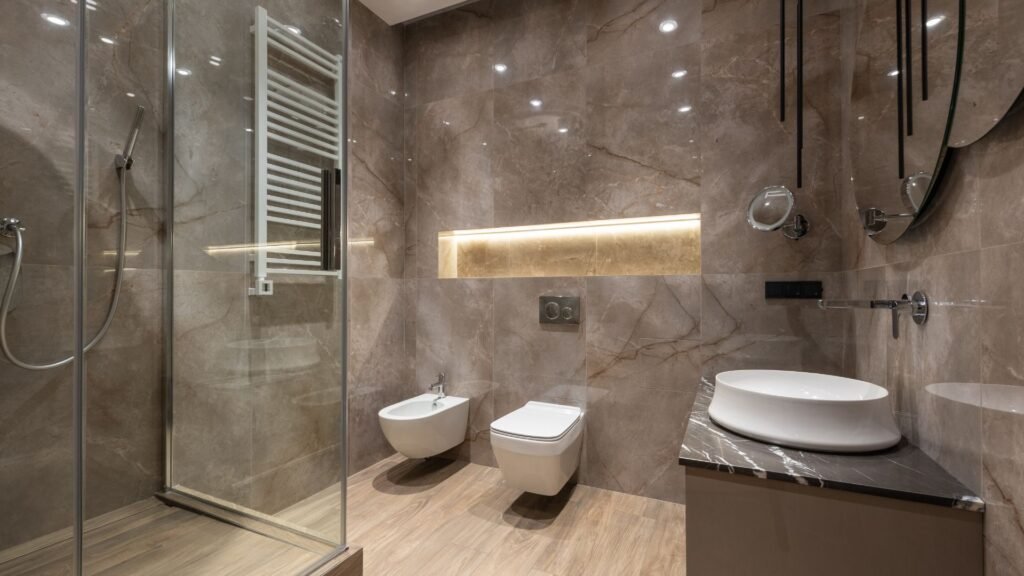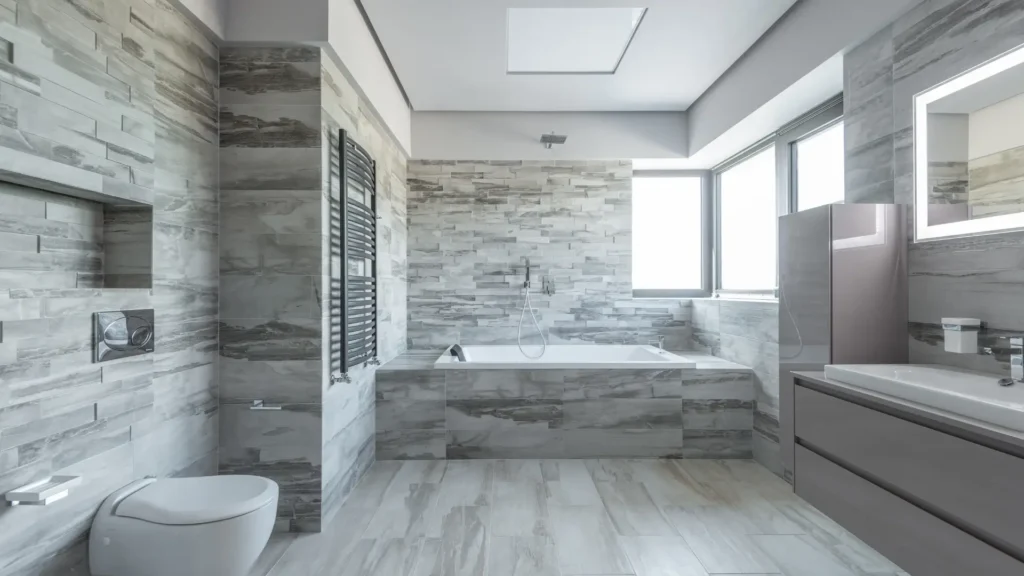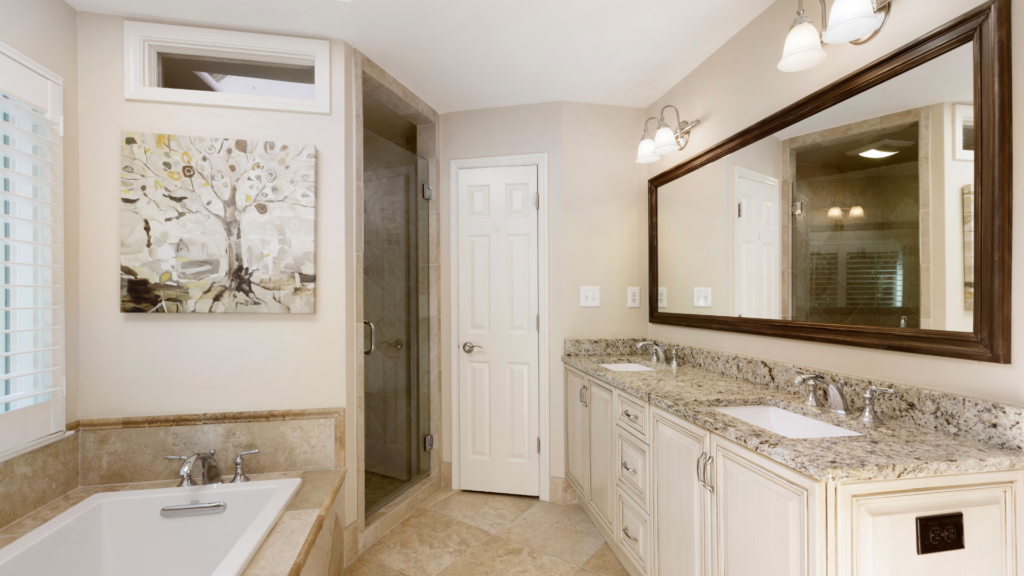Welcome to your go-to guide for understanding bathroom renovation costs in NZ. Whether you’re planning a simple refresh or a full remodel, knowing what to expect financially can save you stress, time, and money. Renovating a bathroom isn’t just about picking new tiles or a modern vanity, it’s about balancing style, function, and budget in one of the most used spaces in your home. Costs can vary widely depending on location, materials, labour, and the size of your project. In this post, we’ll break down what you can realistically expect to pay, where your money goes, what hidden expenses to watch out for, and smart ways to plan without cutting corners. If you’re about to start your bathroom upgrade journey, this guide will help you move forward with confidence.
Bathroom renovation costs in NZ typically range from $10,000 to $35,000, depending on the size of the bathroom, materials used, labour rates, and design complexity. Budget renovations start around $10,000, mid-range updates cost between $15,000–$25,000, while high-end projects can exceed $30,000. Always factor in hidden costs like plumbing upgrades or consents when budgeting.
- Why Bathroom Renovation Costs Vary In NZ
- What’s The Average Bathroom Renovation Cost In NZ?
- Key Cost Factors To Consider
- What’s Usually Included In A Bathroom Renovation Quote?
- Hidden Costs People Forget
- How To Save Money Without Cutting Corners
- DIY Vs Hiring Professionals: What’s Worth Doing Yourself?
- Real Homeowner Examples
- Tips For Planning A Bathroom Reno Budget
- When Is The Best Time To Renovate In NZ?
- FAQs: About Bathroom Renovation Cost NZ
- How much does a basic bathroom renovation cost in NZ?
- What’s the average cost of a mid-range bathroom upgrade?
- How much should I budget for a luxury bathroom remodel?
- Do I need council consent for bathroom renovations in NZ?
- What are the most expensive parts of a bathroom renovation?
- How long does a typical bathroom renovation take?
- What hidden costs should I be aware of?
- Can I save money by doing part of the renovation myself?
- How can I make sure my renovation stays within budget?
- When is the best time of year to renovate a bathroom in NZ?
- Conclusion
Why Bathroom Renovation Costs Vary In NZ
Bathroom renovation costs in New Zealand can differ significantly depending on several key factors. If you’re planning a bathroom upgrade, it’s important to understand why two similar projects might come with very different price tags. Here’s a breakdown of the most common reasons behind the cost variation.
Location Differences (Auckland Vs Smaller Towns)
Where you live in New Zealand can have a big impact on what you’ll pay. Homeowners in Auckland often face higher renovation costs compared to those in smaller towns like Whangarei, Napier, or Invercargill. The reason? Higher demand for skilled trades, higher living costs, and increased material delivery charges in larger cities. In rural areas or smaller communities, tradie rates are often more affordable, and the pace of work may be more flexible. But keep in mind that product availability may be limited, which can affect delivery times and material costs.
Labour Rates And Availability
Labour is one of the biggest expenses in any bathroom renovation. The cost and availability of licensed professionals like plumbers, electricians, and tilers vary from region to region. In high-demand areas, you may face longer wait times or pay a premium to secure a reputable contractor. In contrast, some regions may offer more competitive rates due to less demand. It’s also worth noting that experienced professionals often charge more, but they usually complete the job faster and with fewer issues, which can save you money in the long run.
Size Of The Bathroom
The bigger the bathroom, the more materials you’ll need and the longer the job will take. A compact ensuite is usually cheaper to renovate than a full-sized family bathroom. Larger bathrooms require more tiling, paint, fixtures, waterproofing, and labour hours. Even minor additions, like installing a second vanity or a separate shower and tub, can drive up the overall cost. Always measure your space and plan your layout carefully to avoid unexpected expenses.
Type Of Home (New Build, Villa, Apartment)
The age and type of your home also play a big role in renovation costs. Renovating a bathroom in a new build is often more straightforward because the plumbing and electrical systems are up to date and meet current building codes. In older homes like villas or bungalows, there’s a higher chance of hidden problems, such as outdated wiring, damaged timber, or old plumbing that needs replacing. Apartments can also present challenges due to body corporate rules, limited access for contractors, and shared plumbing systems. These extra steps can add time, complexity, and cost to your project.
Understanding these cost drivers can help you plan smarter and avoid surprises. Each renovation is unique, but knowing what affects your bottom line gives you more control over your budget and expectations. Always get multiple quotes, ask the right questions, and be realistic about what’s possible in your home.
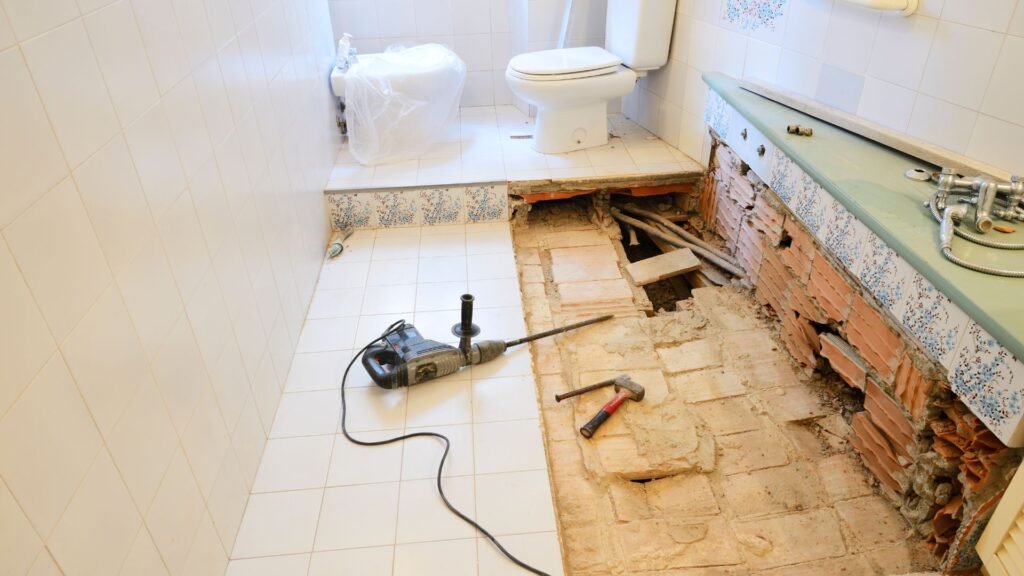
What’s The Average Bathroom Renovation Cost In NZ?
Bathroom renovations in New Zealand come with a wide range of price tags. The final cost depends on the size of the bathroom, the materials used, the scope of the work, and whether you’re hiring professionals or doing part of it yourself. To help you set a realistic budget, here’s a breakdown of typical renovation costs based on three common renovation levels: entry-level, mid-range, and high-end.
Entry-Level (Budget-Focused Refresh)
If you’re working with a tight budget, a basic bathroom refresh is the most affordable option. These renovations typically cost between $8,000 and $15,000, depending on your location and the materials you choose. This level suits homeowners who want to tidy up a dated bathroom without doing a complete overhaul.
What’s Usually Included
- Replacing outdated fixtures (e.g., toilet, taps, or vanity)
- A fresh coat of paint or simple tiling
- Swapping out old lighting
- Basic waterproofing and plumbing work (minimal layout changes)
Most of the cost will go toward labour and essential materials. You’ll be keeping the layout the same, which helps avoid plumbing or electrical rewiring costs. If you shop smart or reuse existing fittings, you may complete the job closer to the lower end of the range.
Mid-Range (Modern Upgrade With Quality Fittings)
A mid-range bathroom renovation in NZ typically falls between $15,000 and $25,000. This level suits homeowners who want a modern, comfortable bathroom with better finishes and possibly some layout improvements.
What’s Usually Included
- Upgraded fixtures with improved design and functionality
- New shower or bath installation
- Tiled floors and part-wall tiling
- Better lighting, mirrors, and ventilation
- Minor layout changes (e.g., repositioning vanity or toilet)
- Improved waterproofing and plumbing
Mid-range renos often involve custom vanities, higher-quality tiles, and more attention to detail. You’ll likely work with licensed builders, plumbers, and electricians to ensure everything is compliant and durable.
High-End (Luxury Finish, Full Redesign)
For a high-end bathroom renovation, expect to spend anywhere from $30,000 to $50,000 or more. This option is for those who want a complete transformation with premium finishes and custom designs.
What’s Usually Included
- Full redesign of the layout and plumbing
- Top-tier fittings and imported tiles
- Frameless glass showers or freestanding bathtubs
- Underfloor heating, LED lighting, and luxury mirrors
- Bespoke vanities and high-end cabinetry
- Designer tiles and finishes throughout
These projects often require council consents, structural adjustments, and project management. You’re not just paying for looks, you’re also investing in comfort, durability, and long-term value.
Price Ranges With Examples (Not Fixed Prices, But Guidance)
Because every home is different, there’s no one-size-fits-all price for a bathroom renovation. Here are three general examples that show how pricing may vary:
- Small, Budget-Friendly Reno in Hamilton: A simple refresh for around $10,000 using off-the-shelf products and minimal trades.
- Mid-Sized Reno in Wellington: A modern update with quality fittings for $20,000, including partial tiling and a new shower.
- Luxury Reno in Auckland Villa: A full gut-and-redesign costing $45,000, featuring custom cabinetry, tile underfloor heating, and a designer bath.
Prices can shift based on local labour rates, access to your bathroom, material availability, and how much you’re willing to DIY or manage yourself.
When planning your renovation, always allow a 10–15% buffer in case something unexpected comes up, because it usually does. Careful budgeting, getting multiple quotes, and knowing your renovation level will help you avoid surprise costs and stay in control.
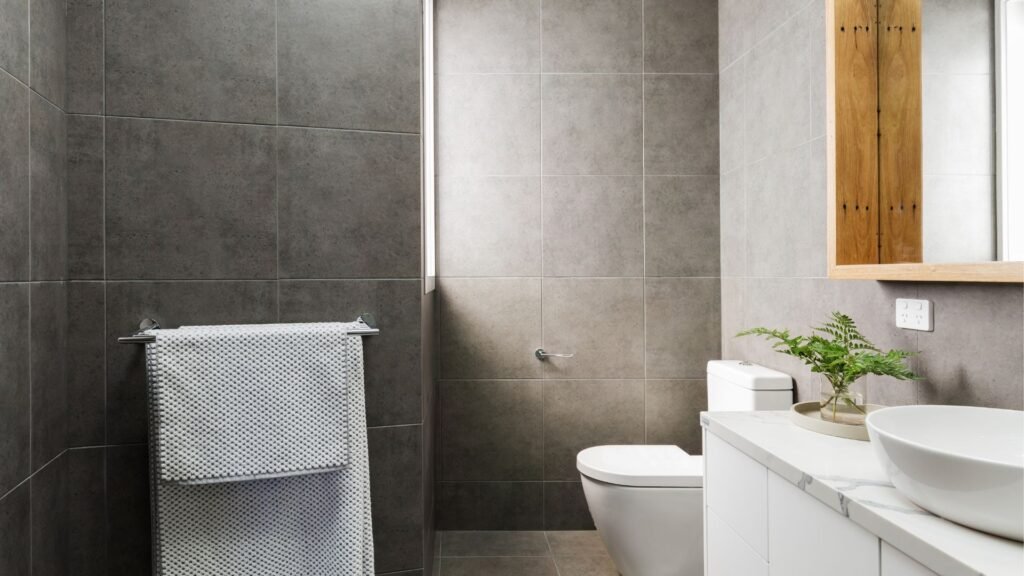
Key Cost Factors To Consider
Understanding what drives the total cost of a bathroom renovation helps you budget smarter and avoid surprises. Whether you’re planning a simple update or a full transformation, several key factors directly affect how much you’ll spend. Below are the major cost areas you should consider before starting any bathroom renovation project in New Zealand.
Materials
Materials make up a large portion of your renovation budget. From the type of tiles you choose to the finish on your tapware, your selections can significantly impact the final cost.
Tiles, Vanities, Showers, Bathtubs, Toilets
The choice of fixtures and finishes can range from affordable to high-end. For example, standard ceramic tiles are much cheaper than natural stone. A basic acrylic bathtub costs less than a freestanding stone or steel tub. Wall-mounted vanities with soft-close drawers or stone countertops cost more than flat-pack options. When choosing fixtures, always consider durability, style, and how each item fits into your budget.
Imported Vs Locally Sourced Products
Imported materials can increase your costs due to shipping, taxes, and longer lead times. Locally sourced products tend to be more affordable and are usually easier to replace or repair if needed. Supporting local suppliers may also help reduce delays, which saves money in the long run.
Labour
Labour is often the biggest cost component in any renovation, especially when you’re working with licensed professionals. In New Zealand, the cost of skilled tradespeople varies depending on your region and the availability of qualified workers.
Plumbers, Electricians, Tilers, Builders
You’ll likely need several trades for a full bathroom upgrade. Plumbers handle pipework, installations, and drainage. Electricians take care of lighting, power points, and extractor fans. Tilers lay floor and wall tiles, and builders manage framing, plastering, and any structural work. Each trade charges differently, and many have minimum call-out rates or day rates.
How Hourly Rates Differ Across Regions
Labour costs are higher in large cities like Auckland or Wellington compared to smaller towns. Demand for skilled workers, travel time, and site access can all influence how much you’ll pay per hour. For example, a plumber in Auckland may charge more than $100 per hour, while in a rural area, you might pay less but wait longer for availability.
Design And Planning
Good planning helps avoid costly changes later in the process. You’ll need to decide early whether to hire a designer or take on the planning yourself.
DIY vs Hiring A Designer
Designing your bathroom layout can save money upfront, especially if you’re comfortable making decisions about fixtures and finishes. But mistakes can be expensive. Hiring a bathroom designer means you get expert guidance, smart space planning, and help with coordinating trades. This service comes with a cost, but it often saves money and time by avoiding errors or rework.
The Impact Of Layout Changes On Cost
Changing the layout of your bathroom, like moving a toilet or shifting a shower, usually means rerouting plumbing and possibly rewiring. This adds to both material and labour costs. Keeping the same layout is a smart way to save money while still upgrading the look and function of the space.
Consents And Compliance
In New Zealand, some renovation work may require council approval, especially if it involves plumbing, structural changes, or drainage. Failing to comply with local building codes can lead to delays or even legal issues.
When You Need Council Approval
If you’re changing the bathroom layout or adding new plumbing fixtures, you may need building consent. Installing a tiled shower over timber flooring often requires proof of waterproofing compliance. It’s always best to check with your local council or hire a project manager who understands the consent process.
Costs Of Consents And Inspections
The cost of getting council approval varies depending on the complexity of your project and your location. You may also need to pay for inspections to confirm that the work meets safety and building standards. These costs can range from a few hundred dollars to over a thousand, so factor them into your renovation budget from the beginning.
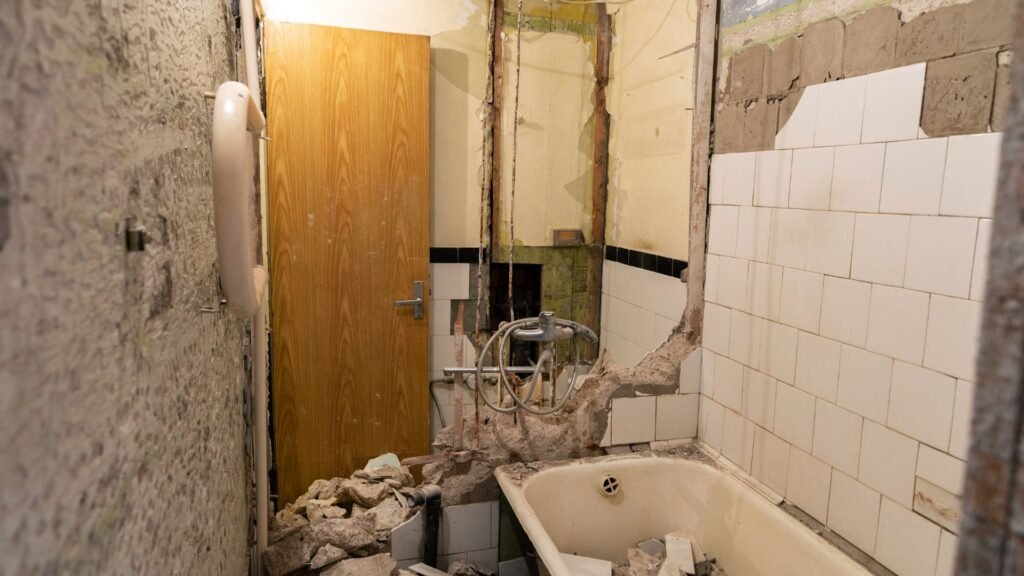
What’s Usually Included In A Bathroom Renovation Quote?
When you request a bathroom renovation quote in New Zealand, it’s important to know what’s typically included in the price. Understanding this helps you avoid unexpected charges and compare quotes fairly between different contractors. While every tradie or company may break things down differently, most comprehensive quotes will include several core services.
Let’s take a closer look at what you should expect.
Demolition And Waste Removal
This is usually the first step in any renovation. It covers the safe removal of your old bathroom fittings, like vanities, toilets, showers, and sometimes even walls or flooring. The quote should also include the cost of skip bins or professional waste removal services to dispose of the debris properly. If asbestos is found during demolition (common in homes built before the 1980s), this could add extra costs, but it won’t usually be part of a standard quote unless it’s been identified beforehand.
Plumbing And Electrical Work
This is where a good portion of your budget goes. A qualified plumber will be needed for anything involving water supply, drainage, or installing new plumbing points. If you’re changing the layout of your bathroom, like moving the toilet or shifting the vanity, the plumbing work becomes more complex and costly.
On the electrical side, the quote often includes installing new lighting, extractor fans, heated towel rails, power points, and underfloor heating (if requested). Always make sure the work is being done by licensed professionals to meet NZ regulations.
Fixtures And Fittings
This part of the quote covers the supply and installation of bathroom essentials like the shower, bath, vanity, toilet, tapware, mirror, towel rails, and any cabinetry. Some quotes will include only the installation cost, while others might include a fixed allowance for supply. Ask your contractor whether you’ll be selecting and buying the fixtures yourself or if they’re sourcing them for you.
If you’re using premium or custom fixtures, the cost will rise. Make sure the quote specifies brands or quality levels, so you’re not caught off guard later.
Painting And Tiling
Once the waterproofing and structural work are complete, the next phase is finishing the surfaces. Most renovation quotes include tiling for walls and floors, sometimes with a square meter cost if you’re using more expensive tiles.
Painting of the ceiling and any non-tiled walls is usually part of the deal. Some homeowners choose to do the painting themselves to save on labour, but professional painters deliver a cleaner, longer-lasting finish. If you’re using bold tile patterns or feature walls, you might see an extra line item for that.
Waterproofing
Waterproofing is a critical part of any bathroom renovation in New Zealand. It prevents leaks, mould, and long-term structural damage. A certified waterproofer will apply a membrane to the shower area and often the entire floor, depending on the layout.
This process must comply with the NZ Building Code, and the person doing the work should provide a certificate of compliance. Don’t cut corners here, many insurance claims are denied due to non-compliant waterproofing. A solid quote will clearly outline this step as part of the core work.
Each of these categories plays a major role in your renovation’s final quality and cost. If anything listed above is missing from a quote, ask for clarification. It’s better to be clear upfront than face budget blowouts halfway through your project.
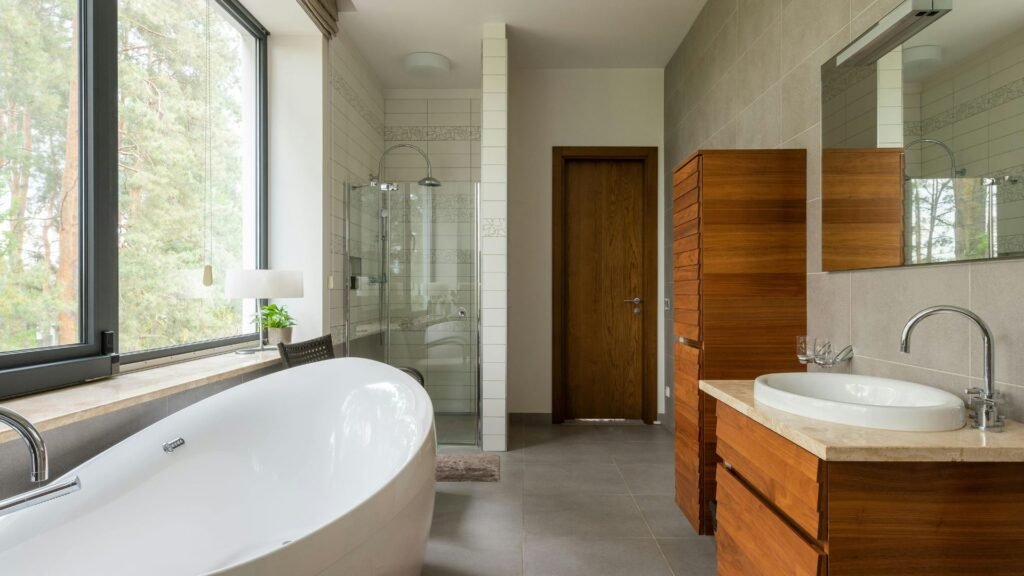
Hidden Costs People Forget
Renovating a bathroom is more than picking tiles and installing new fixtures. Many homeowners focus on the visible parts, like showers, vanities, and tapware, without preparing for the behind-the-scenes costs that can appear during the renovation process. These hidden expenses can add thousands to your budget if not accounted for early. Let’s explore some of the most common hidden costs people forget when renovating a bathroom in New Zealand.
Asbestos Removal In Older Homes
If your house was built before the mid-1980s, there’s a chance that asbestos might be hiding in your bathroom walls, ceilings, or vinyl flooring. Asbestos is a serious health hazard, and its removal must be done by licensed professionals under strict safety guidelines. The cost of asbestos testing and removal can range from a few hundred to several thousand dollars, depending on the extent of contamination. Many homeowners discover this only after demolition begins, which can lead to unexpected delays and added expense.
Upgrading Pipes Or Outdated Wiring
Older homes often come with aging plumbing systems or outdated electrical wiring that no longer meets modern building codes. If you’re renovating a bathroom in a house that’s 30 or more years old, there’s a good chance you’ll need to replace corroded pipes, install new drains, or upgrade your switchboard and outlets. These upgrades are essential for safety and long-term functionality but can quickly increase your renovation costs. Always have your plumber and electrician inspect the current setup before you begin, so you can factor potential upgrades into your budget early on.
Unexpected Water Damage Or Mould
Bathrooms are high-moisture areas, and over time, leaks and poor ventilation can lead to mould growth or hidden water damage behind walls or under flooring. You may not notice it until the renovation starts, and once found, it must be fixed immediately. Ignoring it could risk future structural damage or health issues. Repairs may involve replacing wall linings, flooring, or timber framing, adding both time and cost to the project. To reduce surprises, ask your contractor to do a pre-renovation inspection, especially if you’ve noticed damp smells or stains in the area.
Delivery Fees And Material Delays
When ordering tiles, fixtures, or custom-made vanities, it’s easy to overlook the cost of shipping, especially if you’re ordering from out of town or overseas. Delivery fees for bulky or fragile items can be significant. In some cases, material delays can also lead to timeline blowouts. A late-arriving shower enclosure or missing tapware might stall progress, causing added labour costs if tradies have to reschedule. To avoid this, confirm delivery timelines before purchasing, and aim to have all major materials on-site before the renovation begins.
These hidden costs don’t need to catch you off guard. With smart planning, open communication with your tradies, and a little buffer in your budget, you can manage them effectively and keep your bathroom renovation on track.
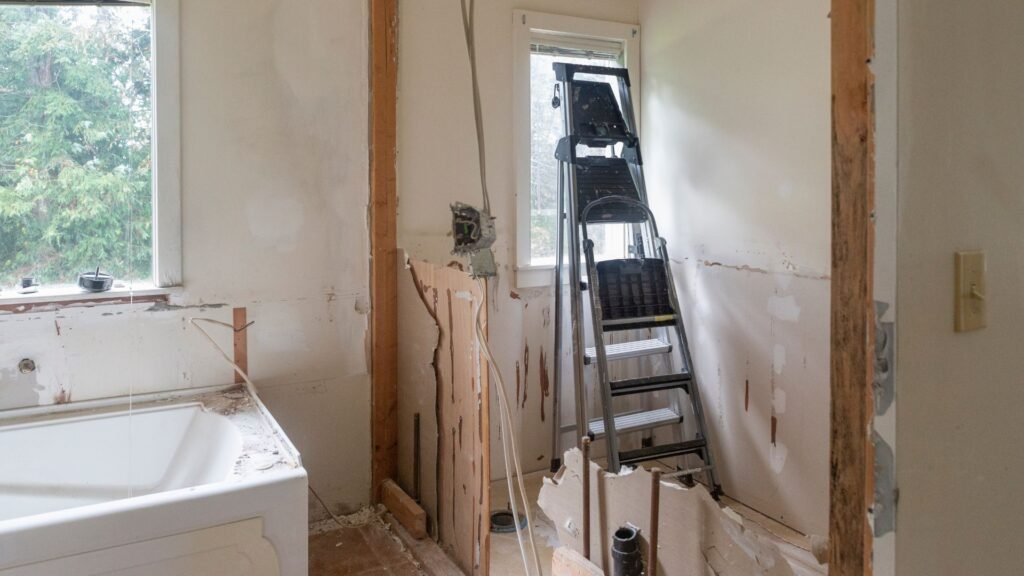
How To Save Money Without Cutting Corners
Renovating a bathroom in New Zealand can get expensive quickly. But the good news is, you don’t need to sacrifice quality to keep costs under control. By planning smart and making a few practical decisions, you can still get a bathroom that looks great, functions well, and lasts for years, without blowing your budget. Here’s how to save money without cutting corners or settling for poor results.
Reuse What You Can (Vanity, Mirror, Layout)
One of the easiest ways to reduce renovation costs is by reusing elements that are still in good condition. If your existing vanity is sturdy and fits the style you’re going for, consider giving it a facelift with a fresh coat of paint or new handles instead of replacing it. Mirrors, towel rails, and shelving can often be reused as-is or slightly modified.
Also, keeping the same bathroom layout can save thousands. Moving plumbing, especially toilets and showers, means extra work for plumbers and waterproofing specialists. If the current layout works well, build your new design around it. You’ll reduce costs and avoid unexpected surprises.
Buy Materials During Sales Or Clearance
Timing your purchases can make a big difference. Look out for seasonal sales at hardware stores, bathroom showrooms, or online retailers. You can often find quality tiles, vanities, and tapware on clearance or as ex-display items at a significant discount.
Before committing, compare prices across suppliers and check for bulk deals. Some retailers also offer package bundles that include everything from the vanity to the toilet and shower at a reduced price. Buying smart doesn’t mean buying cheap, it means knowing when and where to get the best value.
Do Your Own Painting Or Demolition If Safe
Labour is one of the biggest expenses in any bathroom renovation. While plumbing and electrical work should always be left to licensed professionals, tasks like painting, removing old fittings, or light demolition can often be done by you, if you feel confident and have the right safety gear.
By removing old vanities or tiles yourself, you can save several hundred dollars. Painting is another area where DIY can pay off. Just make sure the space is properly prepped, well-ventilated, and that you use mould-resistant paint suitable for bathrooms.
Don’t take risks with anything structural or involving pipes or wires. But if it’s simple, non-hazardous work, doing it yourself can help reduce the budget without affecting the outcome.
Get At Least 3 Quotes From Licensed Tradies
Never settle for the first quote you receive. Reach out to at least three licensed tradies, and make sure they each inspect the space in person before giving an estimate. A good quote should include labour, materials (if supplied), timeframes, and any council-related costs.
When comparing quotes, don’t just look at the total price. Check the level of detail, the brands of materials included, and the tradie’s reputation. A slightly higher quote might include better quality fittings or a more reliable timeline.
Hiring the right professionals also reduces the chance of costly mistakes or delays later on. You’ll get better results, and you won’t have to pay for fixes due to shortcuts or inexperience.
Saving money during a renovation doesn’t mean choosing the cheapest option, it means choosing the smartest one. Reuse where you can, shop strategically, get involved where it’s safe, and always work with trusted tradies. That’s how you stretch your budget without sacrificing quality.
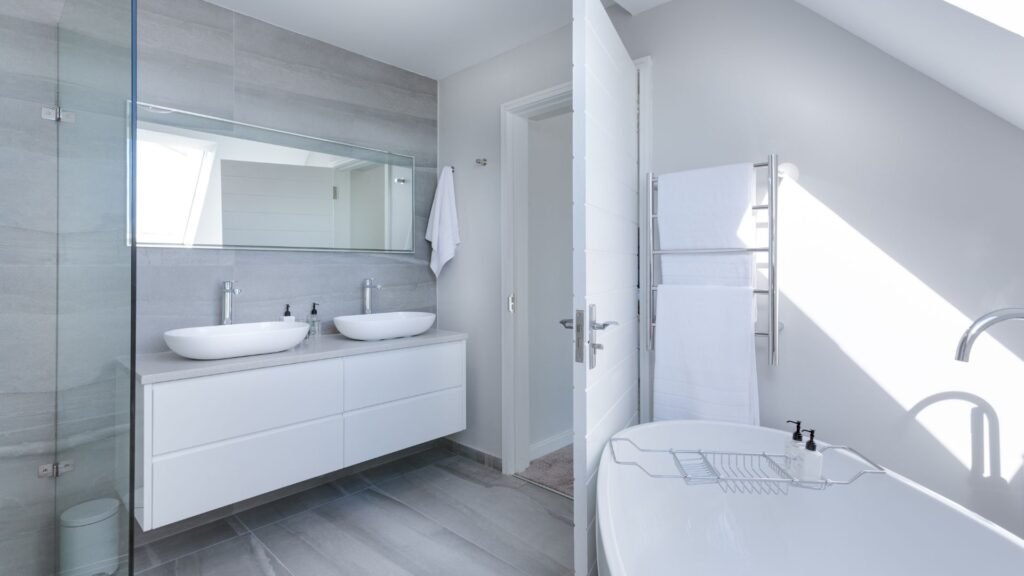
DIY Vs Hiring Professionals: What’s Worth Doing Yourself?
Renovating your bathroom is a major project, and one of the biggest decisions you’ll face is whether to take the DIY route or hire licensed professionals. While it might be tempting to save money by doing everything yourself, not all tasks are safe or legal for unqualified individuals. Below, we’ll explore what’s worth tackling on your own, what’s best left to the experts, and why cutting corners can cost you more in the long run.
Pros And Cons Of DIY
Pros
- Cost Savings: Labour is one of the most expensive parts of a bathroom renovation. Doing basic tasks like demolition, painting, or installing accessories can shave thousands off your total cost.
- More Control: You can work at your own pace and make on-the-spot decisions without waiting on tradespeople.
- Personal Satisfaction: There’s a real sense of achievement in completing parts of your own renovation.
Cons
- Time-Consuming: DIY can stretch your project timeline, especially if you’re working weekends or after hours.
- Skill Limitations: Most homeowners lack the technical knowledge to handle plumbing, electrical work, or waterproofing properly.
- Mistakes Can Be Costly: If something goes wrong, redoing the work might end up costing more than hiring a pro in the first place. Poor workmanship can also reduce the resale value of your home.
What’s Legally Required To Be Done By A Licensed Professional
In New Zealand, the Building Code and plumbing regulations are clear: some tasks are strictly off-limits for DIYers.
You must hire a licensed plumber or certified builder for:
- Installing or altering plumbing systems
- Moving or replacing water pipes
- Installing or replacing showers, toilets, or bathtubs
- Waterproofing wet areas like showers and floors
- Electrical wiring or installing outlets (requires a registered electrician)
Trying to do these jobs yourself isn’t just illegal, it can void your insurance and cause serious safety issues. If you plan to sell your property in the future, non-compliant work could also lead to failed building inspections.
Risks Of Poor Waterproofing And Leaks
Waterproofing is one of the most critical elements of any bathroom renovation. Done right, it prevents leaks, mould, and long-term water damage. Done wrong, it can destroy your walls, floors, and even the structural integrity of your home.
Common DIY waterproofing mistakes include.
- Using the wrong membrane or sealant
- Applying uneven coats
- Not allowing enough drying time
- Skipping wall-to-floor junctions or niches
Once moisture gets behind tiles or walls, it can take months before you notice visible damage, by then, it’s too late. Fixing these issues can cost thousands, and in many cases, the area must be gutted and rebuilt.
Licensed waterproofers follow strict NZ building standards. They also provide documentation or warranties that show the work is compliant, which adds peace of mind and helps if you ever decide to sell your home.
Doing part of your renovation yourself is possible, but it’s important to know your limits. Stick to cosmetic upgrades like painting or updating fixtures, and leave plumbing, waterproofing, and electrical work to the experts. Not only will it protect your home, it will also save you from expensive mistakes.
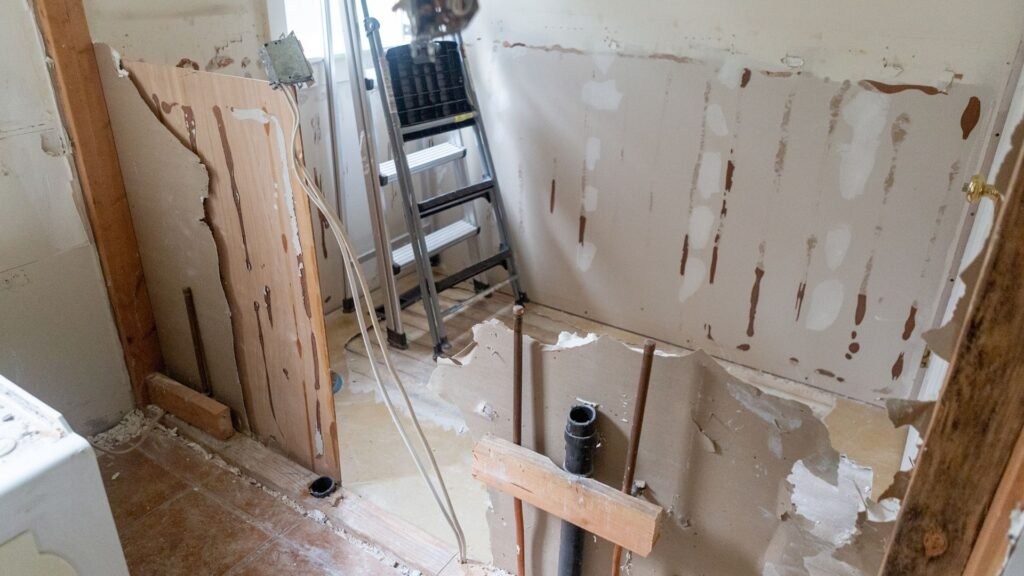
Real Homeowner Examples
Looking at average costs is helpful, but nothing beats seeing what actual bathroom renovations can look like at different price points. Below are three relatable scenarios based on real homeowner experiences and industry averages in New Zealand. These examples give you a clearer idea of what’s possible depending on your budget, goals, and priorities.
Small $10k Makeover
- Who It Suits: First-home buyers, landlords, or homeowners who just want to freshen up a tired bathroom without going overboard.
What Was Done
Megan and Jason own a 1970s unit in Hamilton. Their bathroom was functional but dated, think yellow tiles, old taps, and faded vinyl flooring. They had a tight budget of $10,000 and didn’t want to move any plumbing.
They painted the walls, replaced the vanity, installed a pre-fab shower, added new tapware, and laid vinyl plank flooring. To save costs, Jason did the demo work himself, and they chose affordable fixtures from Mitre 10 and Bunnings.
How It Turned Out
The bathroom looked completely refreshed. While it wasn’t fancy, it felt clean, modern, and much more usable. They stayed under budget and didn’t need council consent.
What They Spent On
- Vanity and tapware: $1,500
- Prefab shower: $1,800
- Flooring: $1,000
- Labour: $4,500
- Paint and accessories: $700
- Miscellaneous costs: $500
Mid-Range $20–30k Update
- Who It Suits: Growing families, homeowners renovating before selling, or people ready to upgrade but not splurge.
What Was Done
Paul and Lisa live in a 1990s home in Wellington. Their bathroom was dated and didn’t function well for their family of four. With a $25,000 budget, they wanted a more practical layout, better storage, and a touch of style.
They moved the vanity to a different wall, installed a frameless glass shower, added a back-to-wall bath, and upgraded the lighting. They hired a bathroom designer for the layout and worked with a licensed plumber and builder. Fixtures were mid-range and locally sourced.
How It Turned Out
The new bathroom felt open, bright, and functional. The family loved the extra bench space and better lighting. Although they had to spend a little more for quality tapware and tiling, they were happy with the long-term value.
What They Spent On
- Labour: $10,000
- Fixtures and fittings: $7,500
- Tiling and waterproofing: $4,000
- Design and planning: $2,000
- Electrical and lighting: $1,500
High-End $40k+ Transformation
- Who It Suits: Homeowners in established or luxury homes who want a spa-like retreat or full redesign.
What Was Done
Ella and James own a villa in Auckland and wanted their master bathroom to reflect the rest of their renovated home. They had a $45,000 budget and were prepared for a full gut-and-redesign.
They reconfigured the entire layout, added underfloor heating, installed a freestanding bathtub, custom vanity, floor-to-ceiling tiles, and skylights for natural light. Every fixture was designer-grade, and they worked with a specialist bathroom renovation company.
How It Turned Out
The result was a hotel-style bathroom with premium finishes and smart features. It added both comfort and long-term value to their home. Council consent was needed due to plumbing and structural changes, which they factored into their timeline.
What They Spent On
- Labour and project management: $18,000
- Premium tiles and fittings: $12,000
- Custom vanity and storage: $5,000
- Heating and skylights: $4,500
- Council consents and inspection: $2,000
- Unexpected costs and buffer: $3,500
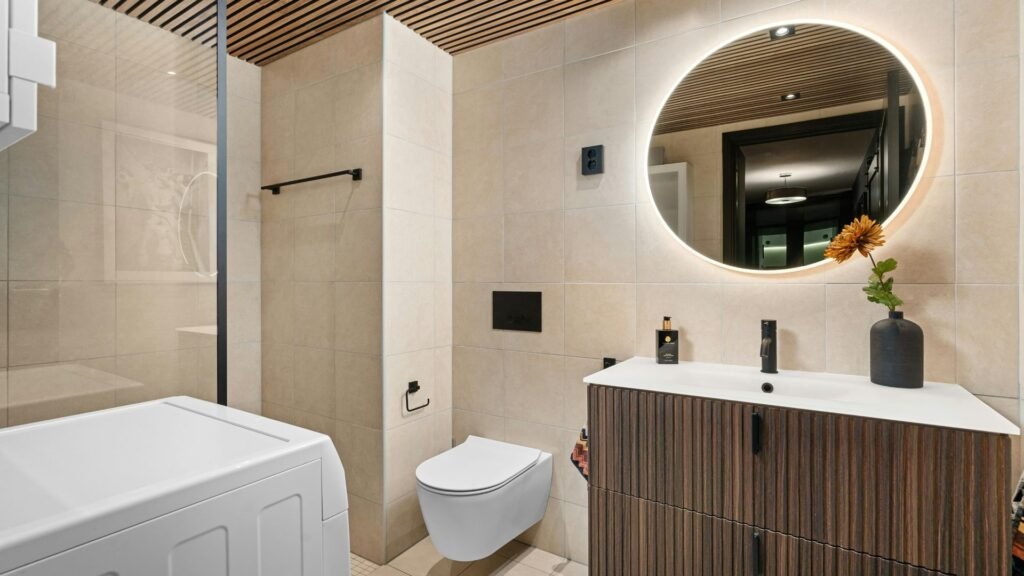
Tips For Planning A Bathroom Reno Budget
Renovating a bathroom is exciting, but without a clear budget, it can easily turn stressful. Planning how you’ll spend each dollar is just as important as picking the right tiles or tapware. Whether you’re renovating a small ensuite or a full master bathroom, having a solid budgeting strategy will help you stay in control and avoid financial surprises along the way.
Below are three essential tips that will guide you through the financial side of your bathroom renovation, with practical steps to make your money go further.
How To Build A Spreadsheet
Start by creating a simple spreadsheet to track every cost, big or small. You don’t need complex software, Google Sheets or Microsoft Excel works perfectly.
Break the spreadsheet into categories like:
- Demolition
- Plumbing
- Electrical
- Waterproofing
- Tiling
- Fixtures (e.g. toilet, vanity, shower, tapware)
- Painting
- Labour
- Permits or council fees
Next to each category, include:
- The estimated cost
- Actual cost once paid
- Payment dates
- Notes for changes or updates
This structure gives you a full view of your spending and keeps your project organised from start to finish. It’s also helpful when comparing quotes or tracking where you may be overspending.
Include Buffer For Unexpected Costs (10–15%)
No matter how detailed your plan is, unexpected costs often pop up. It could be water damage under old tiles, outdated wiring, or price hikes on materials. This is why every bathroom renovation budget should include a contingency fund, ideally 10 to 15 percent of your total budget.
For example:
If your budget is $20,000, set aside $2,000–$3,000 as your safety net. That way, if a surprise comes up, it won’t derail your entire project or force you to downgrade finishes.
This buffer also helps you make last-minute upgrades without guilt, like switching to better tapware or adding underfloor heating.
When To Pay Deposits, Progress Payments, And Final Invoices
Managing cash flow is just as important as knowing your total spend. Here’s a simple way to structure payments during your renovation.
- Deposit: Most contractors will require a deposit before work begins, usually around 10–20% of the total quote. This secures your place in their schedule and helps them order materials.
- Progress Payments: Depending on the size of the job, expect to make one or two milestone payments as work moves forward. These might align with the completion of plumbing, tiling, or fixture installation.
- Final Invoice: The last payment is usually made once the job is completed and you’ve done a final walkthrough. Always make sure you’re happy with the result before paying in full.
- Tip: Get all payment terms in writing before work starts. This avoids any confusion and keeps both you and the contractor on the same page.
Planning your bathroom renovation budget doesn’t need to be overwhelming. With a well-organised spreadsheet, a buffer for the unknown, and clear payment stages, you’ll avoid most of the common pitfalls homeowners face. A little prep goes a long way, especially when every dollar counts.
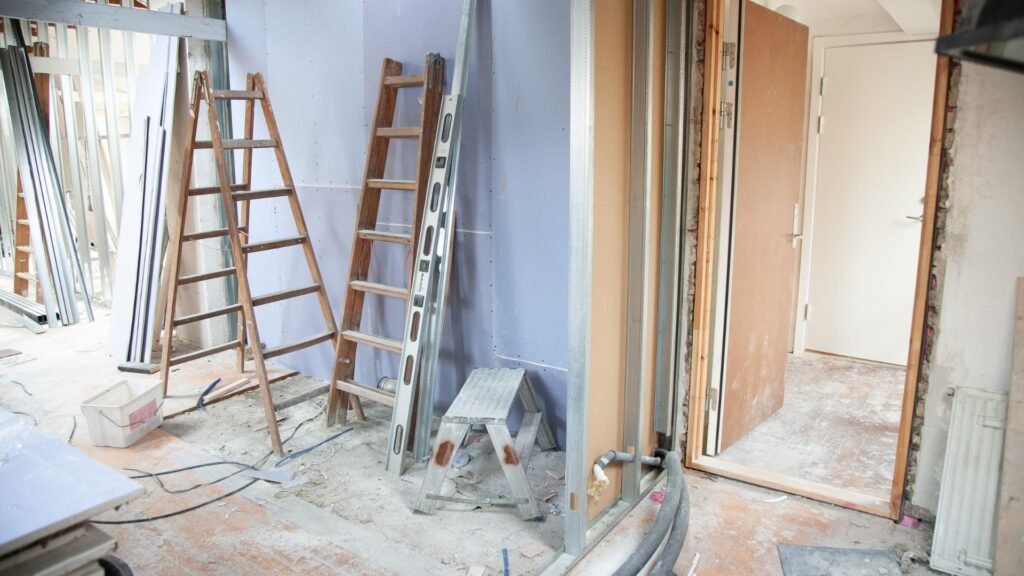
When Is The Best Time To Renovate In NZ?
Planning your bathroom renovation at the right time can make a big difference in cost, timelines, and overall experience. In New Zealand, certain times of the year offer smoother scheduling, faster product delivery, and better weather conditions for specific tasks. Below is a breakdown of what to consider before locking in your renovation dates.
Seasons With Better Tradie Availability
Tradies get booked out fast, especially during summer and before major holidays. If you’re aiming for faster turnaround times and more flexibility in scheduling, consider planning your renovation during the off-peak seasons, typically autumn (March to May) and early spring (September to October).
During these months, builders, plumbers, electricians, and tilers are generally less in demand, which means:
- You’ll likely get multiple quotes faster
- Availability for urgent jobs improves
- You may be able to negotiate better prices or shorter wait times
Avoid the holiday rush between November and February, when many homeowners race to complete projects before Christmas.
Lead Times For Popular Products
Bathroom fixtures like vanities, tiles, and showers can take weeks to arrive, especially if they’re imported. Planning your renovation during slower retail periods, such as early autumn or mid-winter, can help you avoid long backorders.
Showrooms and suppliers often run stocktake or clearance sales during these times. This gives you a better shot at:
- Grabbing discounts on high-quality fittings
- Securing fast delivery on in-stock items
- Avoiding delays caused by high-volume demand
Ordering early and confirming delivery timelines before demolition starts will keep your project running on schedule.
Weather Considerations For Certain Jobs
While most bathroom work happens indoors, weather still plays a role, especially for tasks that involve ventilation, waterproofing, or outdoor access for materials and waste.
For example:
- Wet, cold weather in winter can slow down drying times for paint, plaster, and adhesives
- Poor ventilation may affect moisture control during waterproofing
- Delivery trucks may struggle with access on muddy or flooded driveways
Choosing a dry season like autumn or late spring ensures a more controlled environment, helping tradies complete work efficiently and safely.
Always talk to your contractors early and ask them when their schedules are more open. A well-timed renovation not only saves money but also helps reduce stress and last-minute setbacks.
Need help turning your ideas into a clear plan? Head over to our website and see how we make renovations easier.
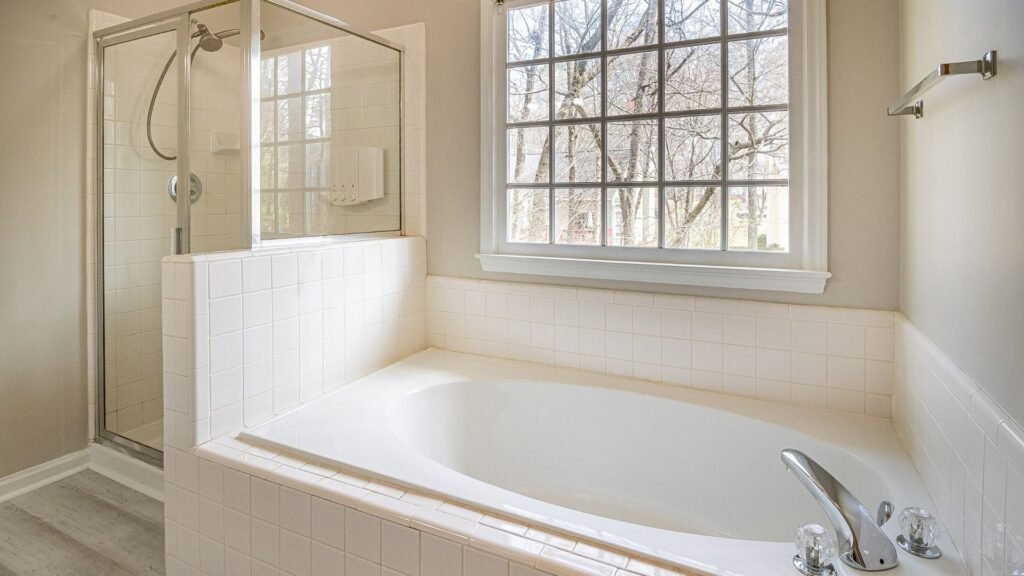
FAQs: About Bathroom Renovation Cost NZ
How much does a basic bathroom renovation cost in NZ?
A basic bathroom renovation in New Zealand typically starts from around $10,000. This usually includes a simple refresh with standard fixtures, basic tiling, and minimal layout changes. The cost can increase depending on the condition of the existing bathroom and any structural or plumbing issues uncovered during the process.
What’s the average cost of a mid-range bathroom upgrade?
Mid-range renovations generally fall between $15,000 and $25,000. These projects include upgraded fittings, custom vanities, quality tiles, and minor layout changes. It also often covers professional labour such as licensed plumbers and electricians.
How much should I budget for a luxury bathroom remodel?
High-end or luxury renovations can range from $30,000 to $50,000 or more. These typically involve premium materials, full layout redesigns, high-spec fittings, underfloor heating, and possibly consented structural changes. Labour costs also tend to be higher for detailed or specialist work.
Do I need council consent for bathroom renovations in NZ?
You don’t usually need consent for cosmetic changes like painting or fixture swaps. However, you may need council approval if the renovation involves altering plumbing layouts, installing new drainage, or structural changes. It’s best to check with your local council before starting the project.
What are the most expensive parts of a bathroom renovation?
Plumbing and waterproofing are often the costliest components, especially if the layout changes. Custom cabinetry, tiling, and imported fixtures can also increase your overall spend. Labour costs make up a significant portion of the total budget.
How long does a typical bathroom renovation take?
A standard renovation takes about 2 to 4 weeks from demolition to completion. The timeframe may extend if consents are needed, materials are delayed, or unexpected issues arise (like rot or mould). Complex projects may take longer.
What hidden costs should I be aware of?
Hidden costs might include plumbing upgrades, outdated wiring, structural repairs, asbestos removal, waterproofing corrections, and delays in product delivery. Always include a buffer of 10-15% in your budget to cover unforeseen expenses.
Can I save money by doing part of the renovation myself?
Yes, you can save on labour by doing minor tasks such as painting, removing old fixtures, or demolition (if safe). But all plumbing and electrical work must be completed by licensed professionals in NZ. DIY waterproofing is not recommended and may lead to compliance issues.
How can I make sure my renovation stays within budget?
Start with a clear plan and a realistic budget. Get at least three quotes from trusted tradies. Choose materials early to avoid last-minute changes. Track all costs in a spreadsheet and allow for a contingency fund in case of surprises.
When is the best time of year to renovate a bathroom in NZ?
Autumn and spring are ideal for renovations, as tradie availability tends to be better outside of summer holiday and winter slowdowns. Planning in advance also helps avoid long lead times on materials during peak demand seasons.
Conclusion
Planning ahead and setting realistic expectations are two of the most important steps you can take before starting any bathroom renovation in New Zealand. Without a clear plan, it’s easy to run into delays, budget blowouts, or changes that cost more than expected. By understanding the average costs, common hidden fees, and the value of working with experienced professionals, you can avoid costly surprises and make smarter decisions. It’s also a good idea to get at least two or three personalized quotes so you can compare services, pricing, and timelines based on your location and needs. Every home is different, so what worked for someone else might not suit your space or budget. If you’re just getting started, check out our free bathroom renovation checklist and budgeting template to help you stay organised and in control from start to finish.
About the Author:
Mike Veail is a recognized digital marketing expert with over 6 years of experience in helping tradespeople and small businesses thrive online. A former quantity surveyor, Mike combines deep industry knowledge with hands-on expertise in SEO and Google Ads. His marketing strategies are tailored to the specific needs of the trades sector, helping businesses increase visibility and generate more leads through proven, ethical methods.
Mike has successfully partnered with numerous companies, establishing a track record of delivering measurable results. His work has been featured across various platforms that showcase his expertise in lead generation and online marketing for the trades sector.
Learn more about Mike's experience and services at https://theleadguy.online or follow him on social media:
